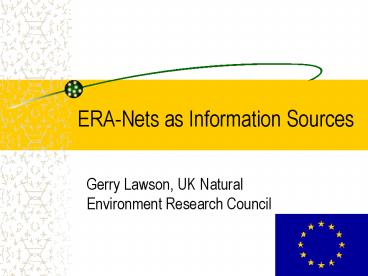ERANets as Information Sources - PowerPoint PPT Presentation
1 / 15
Title:
ERANets as Information Sources
Description:
ERA-Nets as Information Sources. Gerry Lawson, UK Natural Environment Research Council ... Liaise with other relevant ERA-Nets (e.g. SKEP, CIRCLE, MARIN-ERA) and NoEs. ... – PowerPoint PPT presentation
Number of Views:38
Avg rating:3.0/5.0
Title: ERANets as Information Sources
1
ERA-Nets as Information Sources
- Gerry Lawson, UK Natural Environment Research
Council
2
The BiodivERsA ERA-Net
Information WP1
Best Practice WP2
Strategy for Common Call WP3
Links with Developing Countries WP4
Coordinated Call for Proposals
Pan-European Research (art 169)
Management, information and dissemination WP5
3
Coordination of national Programmes ERA-NET -
Facts and Figures
- Level of ambition of selected CA projects
4
Activity Collation Problems
- All ERA-Nets collect Programme information
- Most collect information on Projects
- A few maintain databases of Programmes
- A very few include databases of Project info
- Some collect data on Facilities and
Infrastructures - None collect information on Project Outputs (?)
- Most have problems with Classification
- Most have problems with Gap Analysis
- Most have problems Analysing Spend
(salaries/overheads/shared grants/allocation to
keywords) - Many dont consider studentships
- Some dont record EU Region or country of work.
5
Yet more problems
- Programme databases have little detail defy
classification - Several countries have no Thematic Programmes
- Project databases are structured differently in
each country. - Each country has its own classification system
and wont use anyone elses! - Re-classification is time consuming and
subjective. - Few organisations split funding across
classifiers. - Machine classification of abstracts (indexing)
still needs subjective editing. - Context searches (Google, Autonomy, Collexis) are
avaiable but dont help much with classification.
6
Which is why we need Ontologies?
- An ontology is a formal knowledge organization
(representation system). - It contains concepts, information about these
concepts, relations between these concepts - and instances,
- and it contains information about the relations
between instances and concepts
7
Sample ontology for crop pest management
8
Too many ontologies?
Existing Thesauri and Knowledge Organization
Systems (KOSs)
Dedicated KOSs
e.g., ASFA thesaurus
e.g., the Multilingual Forestry Thesaurus
e.g., the Sustainable Development website
classification
e.g., biological taxonomies such as NCBI and ITIS
Other thematic thesauri
Non-dedicated KOSs
CABI Thesaurus
AGROVOC
NAL Thesaurus
GEmetGEMET
9
What is the starting point?
- FAO maintains the multilingual thesaurus AGROVOC
since the early 80s - Other consistent thesauri are maintained by CABI
in England and the National Agricultural Library
in the States - Various other knowledge organization systems are
scattered around the world - The existing systems are language biased with
English as the leading language but GEMET is
multilingual - BiodivERsA is using 960 terms in the CBD
controlled vocabulary (thesaurus) and creating an
Authority File with synonyms. - It is hoped that keywords allocated to each
abstract will allow clustering classification.
10
The FAO Agricultural Ontology System
OneFish Portal (application on merged ontology)
Forestry Portal (application on merged ontology)
Crop Portal (application on merged ontology)
Merged Ontology- THE AOS
Normalised Ontology
Normalised Ontology
Common data model for local ontologies
Local Ontology
Local Ontology
11
CERIF A European Research Information Standard
12
CERIF building a list of researchers
13
Using CERIF for a Programme Database.
i.
Geographical criteria Applicant nationality
Click add after each selection
Choose the country from the list
14
Classifications and keywords (free/controlled)
Research Topic
Main scientific disciplines
Choose specific fields
Click add after each selection
15
Showing located programmes
16
And specific detail of Programmes
Next steps
- Populate with projects from 19 members (Dec 06)
- Extend to non-members with tropical biodiversity
projects (Feb 07) - Use Indexing to apply keywords (via Authority
File Feb 07) - Invite authors to update add cvs (Mar 07)
- Confirm gap analysis (Mar 07)
- Add research outputs and facilities (June 07)
- Liaise with other relevant ERA-Nets (e.g. SKEP,
CIRCLE, MARIN-ERA) and NoEs. - Participate in any EU Research Ontology
Initiative e.g. with CORDIS.
www.eurobiodiversa.org































